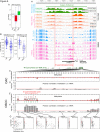Identification of distinct mutational patterns and new driver genes in oesophageal squamous cell carcinomas and adenocarcinomas
- PMID: 28860350
- PMCID: PMC5980794
- DOI: 10.1136/gutjnl-2017-314607
Identification of distinct mutational patterns and new driver genes in oesophageal squamous cell carcinomas and adenocarcinomas
Abstract
Objectives: Oesophageal squamous cell carcinoma (OSCC) and adenocarcinoma (OAC) are distinct cancers in terms of a number of clinical and epidemiological characteristics, complicating the design of clinical trials and biomarker developments. We analysed 1048 oesophageal tumour-germline pairs from both subtypes, to characterise their genomic features, and biological and clinical significance.
Design: Previously exome-sequenced samples were re-analysed to identify significantly mutated genes (SMGs) and mutational signatures. The biological functions of novel SMGs were investigated using cell line and xenograft models. We further performed whole-genome bisulfite sequencing and chromatin immunoprecipitation (ChIP)-seq to characterise epigenetic alterations.
Results: OSCC and OAC displayed nearly mutually exclusive sets of driver genes, indicating that they follow independent developmental paths. The combined sample size allowed the statistical identification of a number of novel subtype-specific SMGs, mutational signatures and prognostic biomarkers. Particularly, we identified a novel mutational signature similar to Catalogue Of Somatic Mutations In Cancer (COSMIC)signature 16, which has prognostic value in OSCC. Two newly discovered SMGs, CUL3 and ZFP36L2, were validated as important tumour-suppressors specific to the OSCC subtype. We further identified their additional loss-of-function mechanisms. CUL3 was homozygously deleted specifically in OSCC and other squamous cell cancers (SCCs). Notably, ZFP36L2 is associated with super-enhancer in healthy oesophageal mucosa; DNA hypermethylation in its super-enhancer reduced active histone markers in squamous cancer cells, suggesting an epigenetic inactivation of a super-enhancer-associated SCC suppressor.
Conclusions: These data comprehensively contrast differences between OSCC and OAC at both genomic and epigenomic levels, and reveal novel molecular features for further delineating the pathophysiological mechanisms and treatment strategies for these cancers.
Keywords: gene mutation; methylation; oesophageal cancer.
© Article author(s) (or their employer(s) unless otherwise stated in the text of the article) 2018. All rights reserved. No commercial use is permitted unless otherwise expressly granted.
Conflict of interest statement
Competing interests: None declared.
Figures







References
Publication types
MeSH terms
Substances
Grants and funding
LinkOut - more resources
Full Text Sources
Other Literature Sources
Medical
Research Materials
